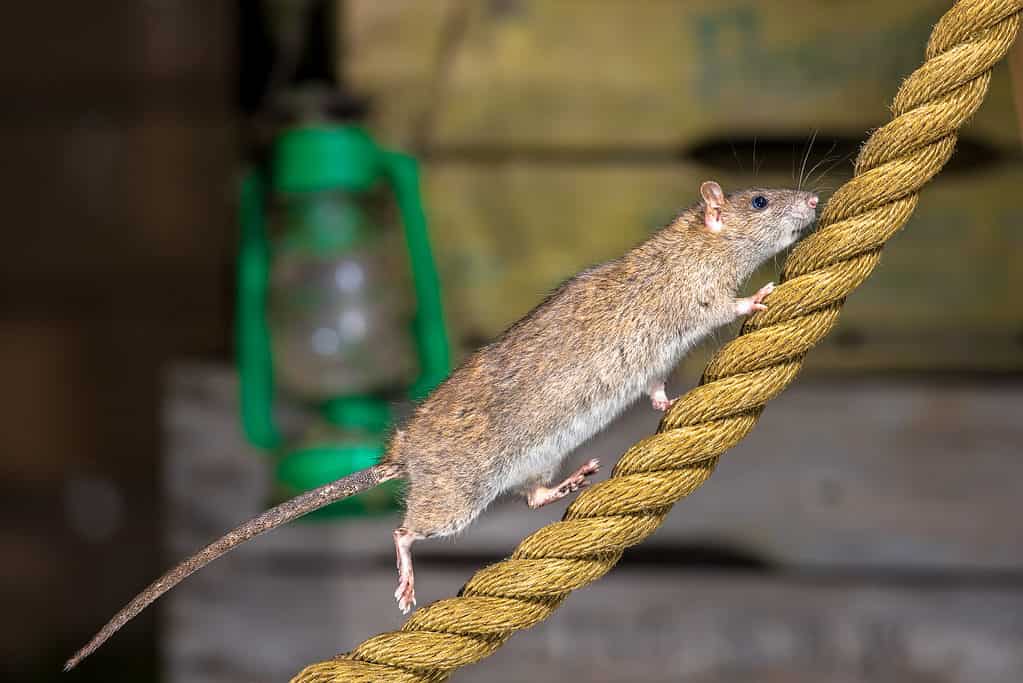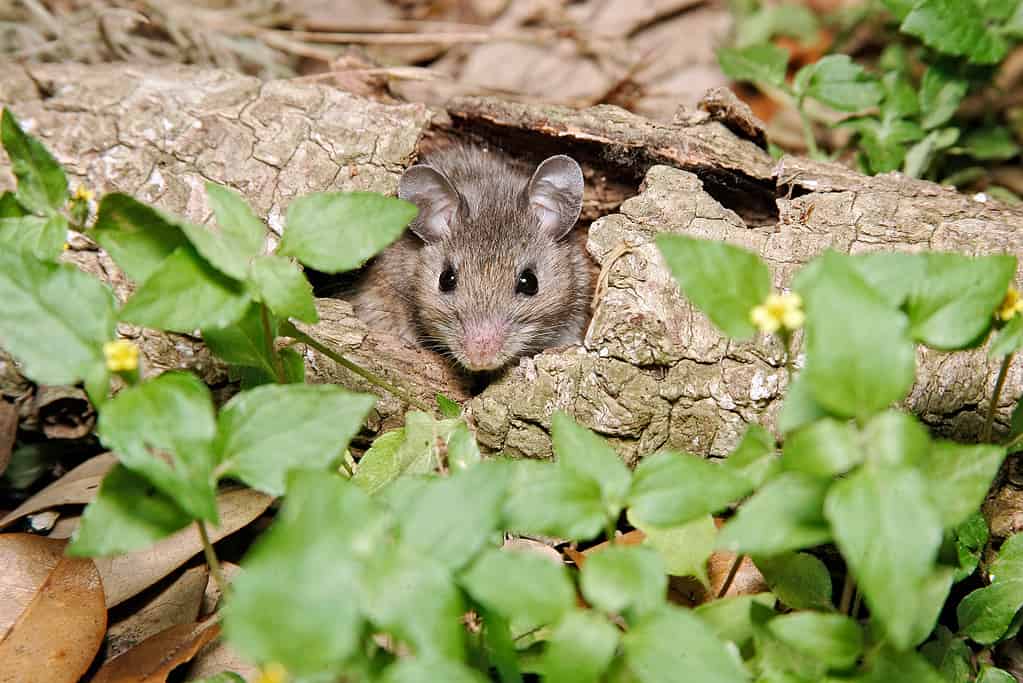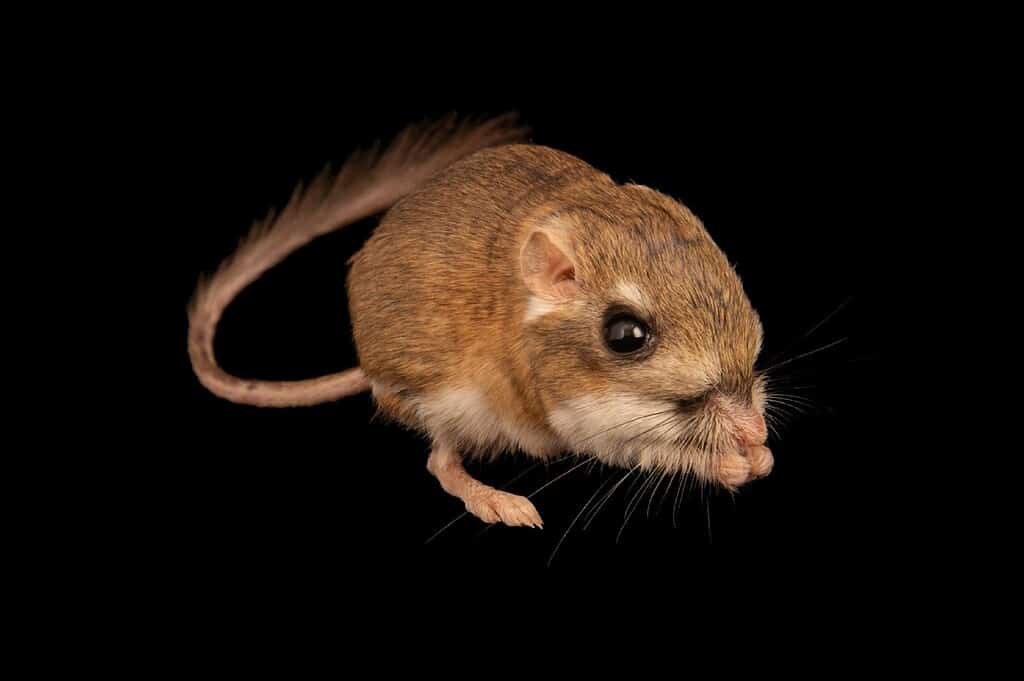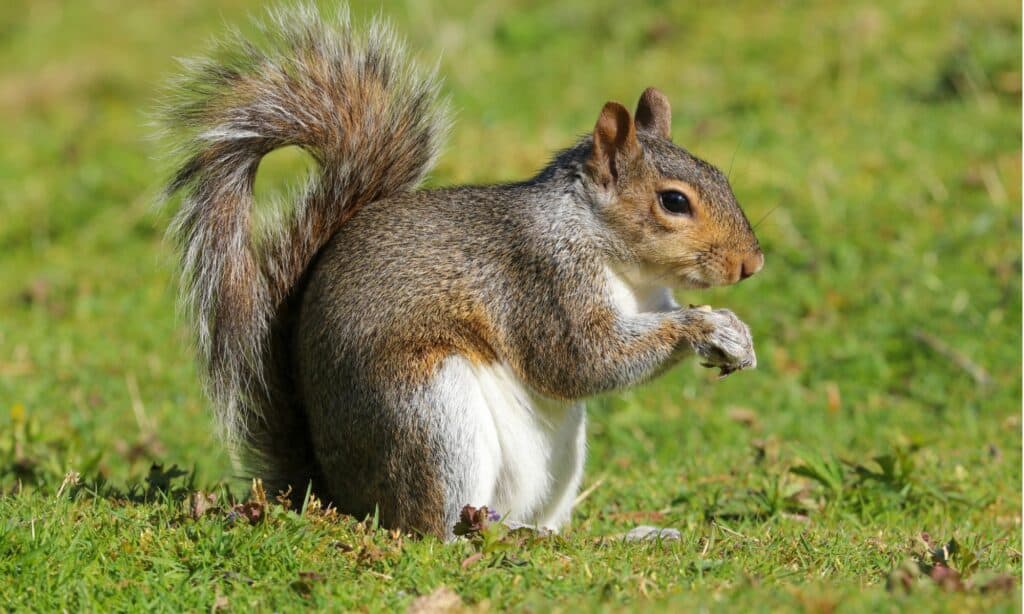In Texas, a land known for its sprawling landscapes and diverse ecosystems, there’s an often-overlooked group of residents scurrying beneath our feet: rodents. These small mammals have thrived in the Lone Star State, exploiting their varied habitats and resources. While some may consider them pests, these creatures play a crucial role in the ecosystem, serving as both prey and predator. In this article, we will shine a light on some of the most common wild rodents that call Texas home, exploring their unique characteristics and the environments in which they flourish.
Brown Rat (Rattus norvegicus)

Brown rats are renowned for their exceptional adaptability and problem-solving abilities.
©iStock.com/CreativeNature_nl
The brown rat, also referred to as the Norway rat or common rat, is a prevalent rodent found across Texas. Exhibiting remarkable adaptability and resourcefulness, this species has successfully established itself as a dominant presence in both urban and rural settings.
Their medium size characterizes them; brown rats, including their tails, typically measure between 12 and 18 inches in length. Their fur ranges from coarse brown to dark grey, with a lighter-colored belly. These rodents possess sturdy, robust bodies, small eyes, rounded ears, and a scaly, semi-naked tail that is marginally shorter than the length of their bodies.
As opportunistic omnivores, brown rats consume a wide variety of foods. They mainly feed on grains, seeds, fruits, vegetables, and insects but will readily scavenge human food waste or even prey on smaller mammals and birds when the opportunity arises.
These versatile creatures can thrive in diverse environments, including urban, suburban, and rural areas. They are often found in close proximity to human settlements, which provide abundant food and shelter. Brown rats construct nests in burrows, walls, attics, sewers, and beneath piles of debris.
In Texas, brown rats can be found state-wide, with dense populations in urban centers such as Dallas, Houston, Austin, and San Antonio. They also inhabit rural areas near agricultural fields, barns, and livestock facilities.
Primarily nocturnal, brown rats are most active during the night. They are social animals that frequently live in large colonies, exhibiting a hierarchical social structure. These rodents are renowned for their exceptional adaptability and problem-solving abilities, making them skilled at eluding predators and locating new food sources.
As an intrusive species, the brown rat has considerably influenced native ecosystems and is frequently perceived as a nuisance owing to its propensity to disseminate diseases and inflict structural harm. This reputation stems from their ability to infiltrate human habitats, exacerbate sanitation issues, and undermine the integrity of buildings and infrastructure. Nevertheless, they continue to represent an essential aspect of Texas’s rich rodent diversity and symbolize the remarkable adaptability and tenacity that characterize these resourceful mammals.
In spite of their undesirable status, brown rats contribute to the overall balance of the ecosystems they inhabit. They serve as a food source for various predators, such as birds of prey, snakes, and larger mammals, thus fulfilling an important role in the food chain. Moreover, their foraging and burrowing activities contribute to soil aeration, which can benefit plant growth and stimulate the cycling of nutrients in certain environments.
Texas Mouse (Peromyscus attwateri)

Known for their agility and swiftness, Texas mice can easily evade predators and catch prey.
©iStock.com/KeithSzafranski
The Texas mouse is a distinct rodent species primarily found in Texas, United States. Belonging to the Cricetidae family, which comprises various mice, rats, and hamsters, this species is exclusive to Texas and exhibits unique characteristics and behaviors.
This medium-sized rodent boasts a body length of up to roughly 8.5 inches. It features brownish-grey fur on its dorsum (or back) and a lighter, cream-colored coat on its ventral side (or underside). The Texas mouse’s large ears and dark eyes are hallmarks of the Peromyscus genus, while its lightly furred, bicolored tail has a slightly darker top than its underside.
An omnivorous creature, the Texas mouse consumes miscellaneous food items such as seeds, nuts, insects, and small fruits. Although it prefers seeds from different grasses and plants, it also feeds on other materials and invertebrates when accessible. The rodent’s diet may fluctuate based on seasonal changes and food availability.
Inhabiting various environments like grasslands, woodlands, and brushy areas, the Texas mouse is especially drawn to rocky outcrops and limestone formations, which offer shelter and protection from predators. These habitats supply abundant food sources and cover for the species.
This rodent is predominantly found in Texas’ central and southern regions, specifically in areas such as the Edwards Plateau, the Balcones Escarpment, and the South Texas Plains. The species has also been spotted in parts of north-eastern Mexico.
The Texas mouse is most active at night. Its adept climbing abilities enable it to thrive on the ground and in trees or shrubs. Known for their agility and swiftness, Texas mice can easily evade predators and catch prey. They build nests from plant materials, typically in crevices or beneath rocks, providing a safe space to raise their offspring and rest during daylight hours.
The Texas mouse’s breeding season generally spans from February to October, though this may vary based on environmental conditions. Following a gestation period of approximately 23 days, females produce a litter of 2-6 pups. Born hairless and blind, these young develop rapidly and achieve independence within approximately 4-5 weeks.
Currently, the IUCN Red List categorizes the Texas mouse as a species of Least Concern due to its stable population and broad distribution. However, potential threats such as habitat destruction, urbanization, and the introduction of non-native species may jeopardize the species’ future. Consequently, conservation endeavors should prioritize preserving and safeguarding native habitats to ensure the long-term survival of this remarkable Texas rodent.
Texas Kangaroo Rat (Dipodomys elator)

The kangaroo rat gets its name from its ability to hop and bound like a kangaroo.
©Usha Roy/Shutterstock.com
The Texas kangaroo rat is a moderately-sized rodent, usually measuring between 4.5 to 5.5 inches in body length, accompanied by a lengthy tail that can be up to twice the length of its body. The rat has a weight range of 1.5 to 3 ounces. Its coat is primarily sandy-brown in color, which assists in camouflage within its surroundings, complemented by a white underbelly. The most prominent feature of this species is its muscular hind legs, significantly larger than its front legs, enabling it to hop and bound, much like a kangaroo, hence its name. Its sizable eyes offer exceptional night vision, while its small, rounded ears provide an acute sense of hearing.
The Texas kangaroo rat predominantly follows a herbivorous diet, mainly consuming seeds from various grasses and forbs. Occasionally, it also feeds on insects and other small invertebrates, which supply a source of protein. The rat is skillful in storing food within its expansive cheek pouches, allowing it to carry seeds back to its burrow for preservation and consumption during times of scarcity.
The preferred environment of the Texas kangaroo rat consists of semi-arid grasslands and sandy terrains characterized by sparse or patchy vegetation. These conditions facilitate the rat’s ability to construct intricate shelter and food storage burrow systems. The burrows typically comprise a main tunnel and several side tunnels, with one or more nesting chambers.
The Texas kangaroo rat inhabits various counties throughout the north-central and western regions of Texas, including Clay, Wichita, Knox, Baylor, Archer, and Foard counties. Its distribution is highly localized and fragmented, with populations usually concentrated in areas that provide suitable habitat conditions.
The Texas kangaroo rat is most active at night. It spends daylight hours resting in its burrow, emerging to forage for food at night. Then, utilizing its robust hind legs, the rat hops and leaps in search of seeds and insects. This distinctive movement mode allows it to evade predators and efficiently navigate its arid surroundings. Generally, the species is solitary, with individuals maintaining their burrow systems and territories, though some overlap may occur.
Despite its limited range within Texas, it fulfills a crucial role in its ecosystem, serving as a seed disperser and prey for various predators.
Gopher (Geomyidae)

Botta’s pocket gopher (
Thomomys bottae) is the most prevalent gopher species in Texas.
©iStock.com/dit:yhelfman
Gophers are small to moderately-sized rodents, typically measuring between 5 and 8 inches long, including their short, bushy tails. They possess a sturdy build with robust forelimbs and powerful, curved claws, which they use for excavation. Gophers boast a thick fur coat that varies in hue from light brown to dark gray, allowing them to camouflage within their environment. One of their unique characteristics is their sizable, fur-lined cheek pouches, or “pockets” utilized for transporting food and nesting materials. In addition, they have petite, rounded ears and small, bead-like eyes, which afford them limited vision since they spend most of their time underground.
Gophers are predominantly herbivorous, consuming extensive plant matter such as roots, tubers, bulbs, stems, leaves, and occasionally even tree bark. They are particularly fond of succulent plants that furnish nourishment and hydration. Occasionally, gophers may ingest insects and other invertebrates as an additional protein source.
Gophers are highly versatile and inhabit various environments such as grasslands, forests, deserts, and even agricultural territories. Their optimal habitat comprises well-drained soils that are effortlessly excavated for their burrows. Gophers are renowned for constructing vast tunnel networks that function as shelter, food storage, and nesting locations. These burrows offer protection from predators and extreme weather while preserving a relatively constant temperature and humidity level.
Gophers are reclusive creatures that dedicate most of their lives to an underground existence. They are territorial and aggressively defend their burrows. They are most active during the early morning and late afternoon, although they may occasionally be observed foraging above ground during the day. Gophers are celebrated for their extraordinary digging prowess, which they utilize to craft intricate tunnel systems and access food sources. Their burrowing activities contribute to soil aeration and nutrient distribution, potentially benefiting plant growth in particular ecosystems.
While many types of gophers can be spotted in the state of Texas, the Botta’s pocket gopher (Thomomys bottae) is the most prevalent gopher species in Texas. It can be found throughout the state, with a denser concentration in Texas’s western and central regions.
Deer Mouse (Peromyscus)

The deer mouse is renowned for its outstanding climbing and swimming abilities.
©jitkagold/Shutterstock.com
The deer mouse is a tiny rodent indigenous to North America and ranks among the most extensively distributed mammals on the continent. Its name stems from its similarity to a petite deer in both coloration and nimbleness.
They are predominantly reddish-brown or grayish-brown on the dorsum and white on the ventral side. Their sizable, dark eyes and rounded ears lend to their charming appearance.
Being omnivorous, deer mice consume an assortment of edibles, such as seeds, nuts, fruits, insects, and diminutive invertebrates. Their diet may vary seasonally, contingent upon the accessibility of food resources.
Deer mice inhabit diverse habitats, encompassing grasslands, forests, deserts, and even alpine regions. Exceptionally adaptable, they can flourish in a wide range of environments, constructing nests in tree hollows, burrows, or rocky fissures. They are renowned for their outstanding climbing and swimming abilities.
Deer mice are nocturnal and are reclusive by nature, except during the breeding season. These rodents possess a keen sense of smell, which they utilize to detect food and communicate with fellow deer mice.
Deer mice are prevalent throughout Texas, dwelling in various ecosystems across the state, such as woodlands, grasslands, and scrublands. They are especially abundant in the eastern and central regions of Texas, but their presence also extends to other areas.
Black Rat (Rattus rattus)

Black rats have an acute sense of smell, which helps them in detecting food and interacting with fellow rats.
©Carlos Aranguiz/Shutterstock.com
The black rat, alternatively known as the roof rat or ship rat, is a moderately-sized rodent with an extensive geographical range. Initially indigenous to Asia, these rodents have since adapted to numerous parts of the world, including North America.
Black rats display a streamlined, lithe build with a body length of roughly 6.5 to 8 inches and a tail length of about 7 to 9 inches. Their fur is chiefly dark brown or black in color and sleek, while the underbelly is generally gray or a lighter shade. Furthermore, these rodents have striking, dark eyes and sizable, rounded ears, which lend to their unique appearance.
As omnivores, these creatures ingest a wide variety of food, including seeds, grains, fruits, vegetables, insects, and even occasionally small vertebrates. Being opportunistic foragers, black rats are noted for adjusting their diet in response to the accessibility of food resources in their habitat.
Black rats are most active at night. They frequently form colonies characterized by intricate social hierarchies. These rodents demonstrate incredible dexterity, climbing ability, and leaping capabilities, which they employ to reach food sources and elude predators. They are recognized for their acute sense of smell, which helps them in detecting food and interacting with fellow rats.
Although black rats can be discovered in assorted regions throughout Texas, they are predominantly concentrated in urban and suburban areas. However, their presence might also be detected in agricultural and rural areas, where they are drawn to grain storage facilities and sustenance resources linked to human dwellings.
Eastern Gray Squirrel (Sciurus carolinensis)

Eastern gray squirrels modify their diet depending on the food sources available.
©iStock.com/Helen Davies
The eastern gray squirrel, occasionally dubbed the grey squirrel or the tree squirrel, is a moderately-sized, tree-dwelling rodent with a vast distribution across North America, including in Texas.
Eastern gray squirrels sport a sturdy, furry physique and a bushy tail. They are gray in color, accented with hints of brown or red, while the underbelly is generally white or light gray. These squirrels possess vivid, dark eyes and comparatively large, tufted ears, which add to their distinctive and cute appearance.
These herbivorous rodents eat nuts, seeds, acorns, fruits, berries, and tree bark. Eastern gray squirrels have also been known to ingest fungi and even bird eggs or nestlings. As adaptable foragers, they effortlessly modify their diet depending on the food sources available.
Eastern gray squirrels predominantly reside in deciduous and mixed woodlands and suburban and urban areas where there are plenty of trees. They are adept climbers and spend a great portion of their day in the trees, looking for food, constructing nests, and escaping predators.
These rodents are diurnal, meaning they are most active during the day, specifically in the early morning and late afternoon. Although they may look cute and fluffy, eastern gray squirrels may display territorial behavior under certain conditions. They are renowned for their nimbleness, speed, and, of course, their fluffy tail! Furthermore, these incredible squirrels showcase impressive memory and problem-solving abilities, frequently caching nuts and seeds to access them later during periods of food scarcity.
The photo featured at the top of this post is © iStock.com/MriyaWildlife
Thank you for reading! Have some feedback for us? Contact the AZ Animals editorial team.







